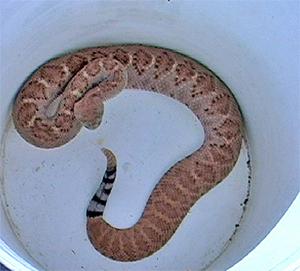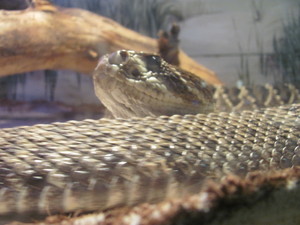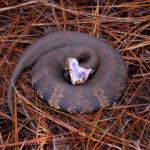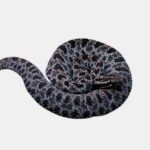Last weekend we were visiting friends who had just come back to the desert for the winter from their summer home in Minnesota. The man went out to the garage to get something and came hurriedly back into the studio apartment where we were sorting garden seeds. He said, “I hear a hissing sound, and there’s either be a leak in a pipe or a rattlesnake in the garage.”
Most of the rattlesnakes I’ve heard have sounded more like a buzzing or rattling of dry leaves noise, as opposed to hissing, but we went out to take a look. As soon as we walked in the door, it began again. We moved some of the items out of the corner where the sound was coming from and there he was with tail vibrating and tongue flashing in and out; but not coiled. After taking the top off of a five gallon bucket, and moving things out of the way in case I needed to make a hasty and unhampered retreat, I got a long handled pitch fork and lifted the snake up and out of the corner. He dropped off, but I got him back on and in the bucket before he could coil or retreat back into the corner. With the lid securely in place, I put him in the back of our pickup truck and we took him five miles out into the desert and released him.
I took some pictures and tried to get some audio but the rattle, which was more of a hissing than the usual loud buzzing sound that I’ve heard before, was too quiet. I have a video and will post it after working with the audio to try to enhance the sound.
The unusual thing about this particular rattler was that it was a Mojave Rattlesnake (Genus: Crotalus scutulatus), and not a Western Diamondback Rattlesnake (Genus: Crotalus atrox). Western Diamondbacks have distinctive diamonds all the way to the tail. The diamonds fade, or aren’t outlined to the tail, on the Mojave. Mojaves have alternating white and black bands on the tail and Western Diamondbacks have black bands. See accompanying photo. We’re supposedly, according to most books and other reference material, out of their range. Six or eight years ago, before I built the perimeter wall around our property, I saw a small Mojave Rattler, about two feet long, in our yard. When I told others about the snake, they said it couldn’t have been because we’re too far east. This time I got a picture, and have three others who saw the snake.
Mojave rattlers are said to be more aggressive and defensive than the other western rattlers. I’ve seen more than just the two here, and all have only wanted to be left alone. All snakes will stand their ground if provoked. They’re also said to reach lengths of two to four feet, making it a medium-sized rattlesnake. I didn’t bother to take the snake out of the bucket to measure it but I’d say, judging by the bucket in the video and the snake along side of the bucket, this snake was pushing the upper size limits that are stated in most literature. But, since it wasn’t supposed to be living here, it probably wasn’t aware it was growing too big.
Most rattlesnake venom is a hemotoxin; Hemo means blood, and most rattle snake venom affects the blood system. Rattlesnake venom is usually a yellowish color. The venom of the Mojave rattler is considered ten times more toxic than other North American rattlesnakes, making the Mojave rattlesnake one of the most dangerous poisonous snakes in the United States. Their venom affects the central nervous system, making it a neurotoxin, and even has its own name; Mojave toxin.
All diamondbacks feed primarily on small rodents, rabbits, eggs (shell and all), birds or anything edible that can be swallowed whole. Snakes use their forked tongue to “taste” the air to find their prey. Pit vipers, like the diamondbacks, have heat sensitive “pits” on the front of their heads, thus the designation “pit viper,” and can locate their quarry even in total darkness.
Mojave diamondbacks are born live, not hatched from eggs, and are nine to eleven inches at birth. Western Diamondbacks can grow to around sixty inches as adults. One piece of information from the University of Texas said they had chronicled a 84″ western diamond back. But Texans have a history of stretching the truth.









